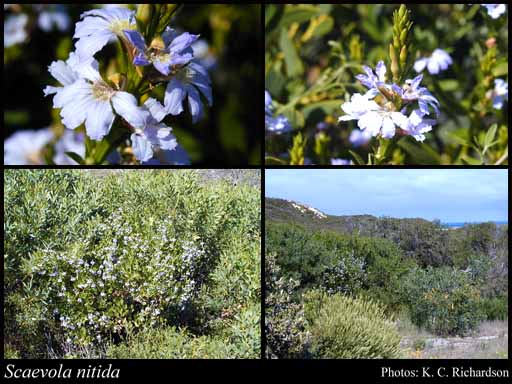- Reference
- Prodr. 584 (1810)
- Conservation Code
- Not threatened
- Naturalised Status
- Native to Western Australia
- Name Status
- Current
Erect shrub, 0.3-3 m high. Fl. blue-purple, Aug to Dec. White or grey sand, clay. Coastal limestone cliffs & dunes.

Scientific Description
Stems ribbed. Leaves flat, 15-65 mm long, 5-28 mm wide, Indumentum absent (leaves glabrous); margins entire or toothed. Bracteoles present, 6-8 mm long, glabrous. Pedicel absent (flowers sessile). Calyx lobes present, Calyx length 7-9 mm long, glabrous. Corolla blue or purple, 15-17 mm long, without auricles, not spurred, glabrous on the outside, hairy on the inside; central lobes 7-9 mm long, with wings; outer lobes 6.5-9.5 mm long, wing present on both sides and clearly unequal, 1-2 mm wide on the narrower side, 1.4-2 mm wide on the broader side. Anthers free. Ovary inferior, not gibbose; style 7-9 mm long, rarely hairy; indusium single, hairy; ovules one or two. Flowers in August, September, October, November and December. Occurs in the Geraldton Sandplains (GS), Swan Coastal Plain (SWA), Jarrah Forest (JF), Warren (WAR) and Esperance Plains (ESP) IBRA Region(s), of the South West (SW) Botanical Province.
Distribution
- IBRA Regions
- Esperance Plains, Geraldton Sandplains, Jarrah Forest, Swan Coastal Plain, Warren.
- IBRA Subregions
- Fitzgerald, Lesueur Sandplain, Perth, Southern Jarrah Forest, Warren.
- IMCRA Regions
- Central West Coast, Leeuwin-Naturaliste, WA South Coast.
- Local Government Areas (LGAs)
- Albany, Augusta Margaret River, Busselton, Cambridge, Cockburn, Coorow, Cranbrook, Dandaragan, Denmark, Fremantle, Gingin, Joondalup, Manjimup, Murray, Nannup, Nedlands, Rockingham, Wanneroo.